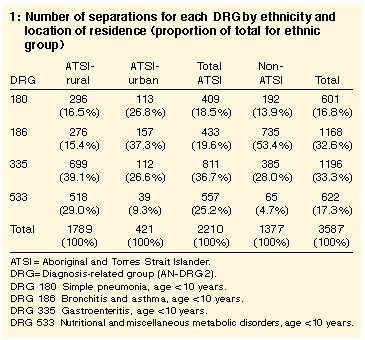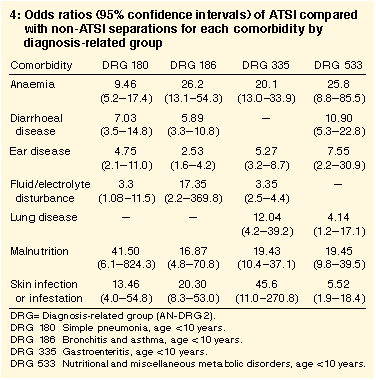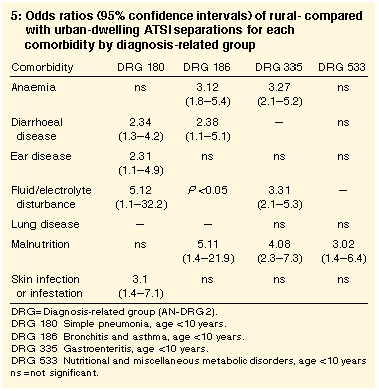Synopsis
- The Northern Territory Health Service implemented a casemix system
of hospital funding in 1996 using national averages and national cost
weights as benchmarks for length of stay and funding. Clinicians and
health administrators were concerned about the potential of this
model to impair health service delivery, especially to children of
Aboriginal or Torres Strait Islander (ATSI) descent, whose current
poor health has been well described.
- Data were collected on children aged under 10 years who were
discharged from the Royal Darwin Hospital between 1 July 1991 and 30
June 1996 and assigned one of four DRGs (simple pneumonia, bronchitis
and asthma, gastroenteritis, nutritional and metabolic
disorders). Data collected included age, sex, ethnicity, duration
of hospital stay, location of residence and presence of
comorbidities.
- There were significant differences in the proportion of children
with multiple comorbidities between ATSI and non-ATSI children, as
well as between rural- and urban-dwelling ATSI children.
- A higher proportion of ATSI compared with non-ATSI children had
prolonged hospital stays (22.6% v. 1.5%), with the variables
influencing length of stay in ATSI children including "age < 2
years", "living in a remote area", and "presence of two or more
comorbidities".
- These results confirm clinical impressions about disease patterns and length of hospital stay in ATSI children, and highlight the problems of imposing a casemix classification system for a "typical" Australian population on a region with a high proportion of people of ATSI descent.
Introduction
In July 1996, the Northern Territory Health Service introduced a casemix-based system of funding to its five acute-care hospitals. Average length of stay was to be benchmarked against national averages and funding based on national cost weights. Clinicians and health administrators were concerned over the potential of this model to impair health service delivery because of the Northern Territory population's high proportion of people of Aboriginal or Torres Strait Islander (ATSI) descent. The poor health of ATSI children has been well described.1 It has been our observation that the disease patterns in hospitalised ATSI children are different and that they have longer lengths of hospital stay.The Top End of the Northern Territory includes the city of Darwin and surrounds with 90 500 people, of whom 8232 (9%) are of ATSI descent, and the Darwin Rural/Remote area with 12 460 people, of whom 9186 (73.7%) are of ATSI descent.2 Of the 17 770 children aged 10 years and under resident in the Top End, 4460 (26%) are of ATSI descent; 2440 (52.7%) of these children live in the rural/remote district.
The implementation of casemix funding made it a matter of urgency to consider whether, and to what degree, length of stay and therefore resource consumption was greater in Aboriginal children. Moreover, were there justifiable reasons for longer hospital stays in ATSI children?
To answer these questions, data were collected at the Royal Darwin Hospital (RDH), a 270-bed teaching hospital, which is the only public hospital in the Top End of the Northern Territory.
Methods
Data collectedSeparation data were obtained for all children aged under 10 years discharged from the Royal Darwin Hospital for the five years 1 July 1991 to 30 June 1996.
Our study sample was drawn from cases coded as normally resident in Darwin or the surrounding rural/remote area and assigned one of four Australian national diagnosis-related groups version 2 (AN-DRG-2). These were 180 (Simple pneumonia, age < 10 years), 186 (Bronchitis and asthma, age < 10 years), 335 (Gastroenteritis, age < 10 years) and 533 (Nutritional and miscellaneous metabolic disorders, age < 10 years). These are the four commonest DRGs assigned to children at Royal Darwin Hospital.
Data were obtained on age, sex, ethnicity, duration of hospitalisation, location of residence and number and nature of the seven most common comorbidities.
Age was grouped into completed years. Ethnicity was coded as reported by the children's parents or guardians as "ATSI" or "other". The duration of hospitalisation was in completed days. Location of residence was categorised according to the Northern Territory Health Service's classification into greater Darwin urban area or Darwin rural/remote area.
The comorbidities were defined from the International classification of diseases 9th revision, clinical modification, 4th edition (ICD-9-CM4). The definitions used were malnutrition (260.0-263.9), anaemia (280.0-285.9), pneumonia and influenza, chronic obstructive pulmonary disease and allied conditions (480.0-491.9), fluid and electrolyte disturbance (276.0-276.9), skin infection or infestation (132, 133, 680-686.9), middle-ear disease (382.0-382.9), and intestinal infectious diseases (001-009.3).
Statistical analysis
As the results were not normally distributed, we calculated the
significance of differences in mean length of stay between the two
groups using the Kruskal-Wallis H test (equivalent to a chi-squared test). For
calculating the significance of difference between proportions of
comorbidities we used 95% confidence intervals (CIs), taking as
significant any result that did not cross zero. We compared the
association of each comorbidity for each DRG between ATSI and
non-ATSI children, and between ATSI rural residents and ATSI urban
residents. We classified as statistically significant any result in
which the 95% CI of the odds ratio did not cross one, unless there was a
zero in the cell, in which case we used a chi-squared test with a Yates'
correction.
To assist comparison between ATSI and non-ATSI children, we defined prolonged length of stay as hospital stay exceeding three times the average for non-ATSI children. We examined the associations of prolonged length of stay in ATSI children, both crude associations and those determined with a multiple logistic regression model using EGRET (Statistics and Epidemiology Research Corporation, Portland, Oregon, USA). We classified as statistically significant any result in which the 95% CI of the odds ratio did not cross one.
Results
During the study period, there were 10 409 paediatric separations, of which 3587 (34.5%) fulfilled the study admission criteria; 2210 of these (61.6%) occurred in ATSI children. Within this cohort, 421 of the 2210 ATSI separations (19.0%) were from urban areas compared with 1352 of the 1377 non-ATSI separations (98.2%); the 25 non-ATSI rural separations have been included with the non-ATSI cases for analysis. The highest number of separations was seen in DRG 335 (gastroenteritis) for rural ATSI cases and DRG 186 (bronchitis and asthma) for non-ATSI and urban ATSI cases (Box 1).
Length of hospital stay
Only 21 of 1377 non-ATSI children (1.5%), as compared with 500 ATSI children (22.6%), had prolonged hospital stays; 19 of the 21 non-ATSI children (90.4%) were urban residents. Of the ATSI children, 34 (8.1%) urban residents and 466 (26%) rural/remote residents had prolonged hospital stays.
The ratios of mean length of stay for ATSI compared with non-ATSI children varied between 2.0 (for DRG 180 - simple pneumonia) and 3.8 (for DRG 335 - gastroenteritis). For all four DRGs, differences in mean length of stay between urban- and rural-dwelling ATSI children were statistically significant, but not as marked as ATSI/non-ATSI differences (Box 2).
2: Comparison of mean length of stay in days (SD)
| DRG | |||||||
| 180 | |||||||
| 186 | |||||||
| 335 | |||||||
| 533 | |||||||
| Total | |||||||
|
ATSI = Aboriginal and Torres Strait Islander. DRG = Diagnosis-related group (AN-DRG-2). DRG 180 Simple pneumonia, age < 10 years. DRG 186 Bronchitis and asthma, age < 10 years. DRG 335 Gastroenteritis, age < 10 years. DRG 533 Nutritional and miscellaneous metabolic disorders, age < 10 years. | |||||||
Comorbidities
There were also significant differences in the proportion of
children with multiple comorbidities between ATSI and non-ATSI
children, as well as between rural- and urban-dwelling ATSI
children, with the most marked differences occurring when two or more
comorbidities were present (Box 3).
3: Number of comorbidities (percentage of total for ethnic group)
| No. of comorbidities | |||||||
| 0 | |||||||
| 1 | |||||||
| 2 | |||||||
| 3 | |||||||
| 4 | |||||||
| 5 | |||||||
| ATSI = Aboriginal and Torres Strait Islander *Statistically significant difference in proportions. | |||||||
The small number of non-ATSI children with comorbidities precluded comparing mean length of stay and comorbidities for DRGs 180, 186 and 533. However, for DRG 335 (gastroenteritis) there was a significant difference between the mean length of stay for ATSI versus non-ATSI children (7.5 v. 2.2 days; P < 0.01), and ATSI-rural versus non-ATSI children (8.1 v. 2.2 days; P < 0.01) when a comorbidity was present.

Compared with non-ATSI children, ATSI children were significantly more likely to have any of the comorbidities for all the studied DRGs, with the strongest associations being with malnutrition, skin infection/infestation and anaemia (Box 4). Compared with ATSI urban-dwelling children, ATSI rural children were also significantly more likely to have comorbidities, with malnutrition strongly associated (Box 5).

Factors influencing length of stay
On multiple regression analysis of variables influencing length of
stay in ATSI cases, "age less than 2 years", "living in a remote area"
and "the presence of two or more comorbidities" were the commonest
statistically significant associations on both univariate and
multivariate analysis. For both crude and adjusted analyses the
comorbidity "malnutrition" was significantly associated with
prolonged stay for all applicable DRGs (Box 6).
Discussion
DRGs are created at a federal level as a means of bundling inpatient episodes to guide hospital funding. The bundled episodes are homogeneous both clinically and in resource use. Although DRGs have been refined, this has been done using national length-of-stay data.
Our study shows the dangers of imposing a classification system for a "typical" Australian population on a region with a high proportion of people of ATSI descent. The Royal Darwin Hospital's 10 409 paediatric separations in the study period included 5180 ATSI children (49.8%), of whom 4221 (81.5%) were from rural or remote areas. These children have quite a different disease course, with a high admission rate, many comorbidities and a clinically justified prolonged length of stay related to the number of comorbidities.
The DRG classification's capacity to cater for different populations with the same diagnosis is limited. New classification approaches have been postulated to take into account severity and comorbidities.3 The "clinical complexity level" refinement project currently being undertaken by the Commonwealth Department of Health and Family Services is addressing the impact of complications and comorbidities on DRGs, with the possibility of optimising DRG splits (Development of Australian refined diagnosis-related groups, version 4, volume 2, Commonwealth Department of Health and Family Services, to be published January 1999). Moreover, AR-DRG-4 has an alphanumeric coding system potentially facilitating such splits. For example, in AR-DRG-4 the code for gastroenteritis in children under 10 years is G68 with a split for complicating factors -- G68A/G68B -- with the possibility of adding further letters for further splits.
A recent multicentre study has confirmed that ATSI inpatients in remote hospitals in Australia have longer lengths of stay and consume more resources in most of the Major Disease Categories (MDCs)4 (see Fisher et al). Our study supports these data and suggests that improving the health of Aboriginal children by reducing comorbidities would reduce hospital costs.
Our study highlights the heterogeneity of Aboriginal patients, with those in remote communities having more comorbidities. For this reason we do not recommend that ethnicity be classified as part of the DRG system, but that the emphasis should remain on clinical criteria. Unfortunately, however, "Aboriginality" remains a marker of "multiple comorbidities" and at least one State funding formula carries a loading for this patient group.5
Our sample was too small to compare ATSI and non-ATSI patients from remote communities. However, other studies have shown lower hospitalisation rates in the non-ATSI remote populations.6
That some patient populations need special consideration and do not fit national averages is not a new message, but to date many studies aiming to make this point have been descriptive.7,8 Clinicians are being urged to review their data and oversee the impact of casemix-based funding,9 but the number of published quantitative studies remains small. Data-based clinical interpretation is imperative if patients are not to be disadvantaged by output measures being linked to and equated with "efficiency".
These results confirm the clinical impression that there is potential for inappropriate funding of inpatient Aboriginal children under the current classification system. The Northern Territory Health Service is aware of these issues and is implementing a special cost weight in such DRGs; patients in other DRGs remain vulnerable.
References
- Australian Bureau of Statistics and the Australian Institute of Health and Welfare. The health and welfare of Australia's Aboriginal and Torres Strait Islander peoples. Canberra: ABS/AIHW, 1997. (Catalogue No. 4704.0.)
- Population estimates. Darwin: Epidemiology and Statistics Branch, Territory Health Services, NT, 1997.
- Pilla J. Developments of AN-DRGs: meeting the concerns of clinicians. Med J Aust 1994; 161 Suppl Sep 5: S9-S11.
- Commonwealth Department of Health and Family Services. Report on National Aboriginal and Torres Strait Islander Casemix Study. Adelaide: Brewerton and Associates Pty Ltd, April 1997.
- South Australian Health Commission. Casemix funding for health -- hospitals. Adelaide: SA Health Commission, 1997-98.
- Hart FG, Ring I, Runciman C. Public hospital activity, expenditure and staffing levels for indigenous and non-indigenous settlements in remote Queensland. Aust J Public Health 1993; 17: 325-330.
- Henderson A. Casemix-based funding for Queensland discriminates against hospitals treating very sick patients [letter]. Aust N Z J Med 1996; 26: 421-422.
- Stoelwinder JU. Casemix payment in the real world of running a hospital. Med J Aust 1994; 161 Suppl Sep 5: S15-S18.
- Hickie JB. Clinical representation in the development of casemix: measures and applications in Australia. Med J Aust 1994; 161 Suppl Sep 5: S6-S8.
Authors' details
Royal Darwin Hospital, Darwin, NT.Alan R Ruben, FRACP, FAFPHM, formerly, Community Paediatrician, Territory Health Services; currently, Advisor in Paediatrics, Fiji School of Medicine, Suva, Fiji Islands.
Dale A Fisher, FRACP, DTM&H, Physician and Senior Lecturer.
Reprints will not be available from the authors.
Correspondence: Dr A
R Ruben, Fiji School of Medicine, PO Box 11683, Suva, Fiji Islands.
E-mail: alan_rATfsm.ac.fj




